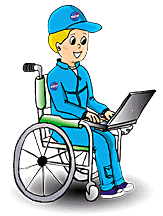![]()
 |
Wow!An important function of the Skylab space station was to take photographs of the Earth using special infrared cameras. One of the pictures enabled scientists to help famine victims in Africa find water. |
| On May 14, 1973, a two-staged Saturn V rocket propelled the 90 metric ton unmanned Skylab space station into an orbit above Earth. Skylab was designed to allow astronauts to live and work in space for several weeks. It was to be a laboratory for astronauts and a base for spacecraft. As the Saturn rocket accelerated, atmospheric drag caused a metal shield to rip away from the lab. A strap attached to the shield caught on one of the solar wings. This pried open the wing. As the rocket continued upward, the solar wing and the shield were thrown into space. The shield, which had been designed to protect the space station from space objects and the Sun's radiation, was essential. Without it, temperatures within Skylab would be too hot for it to be used as a laboratory. |
|
|
A second Skylab crew was launched in July of 1974 and a third in November of the same year. The three Skylab crews spent a combined 171 days, 13 hours, and 14 minutes orbiting the Earth. They circled the Earth 2,476 times and spent over 3,000 hours conducting eight categories of experiments. They also studied the effect living in space had on the human body. Spacewalk time totaled 41 hours and 46 minutes. In addition to the thousands of frames of Earth and solar observation film that resulted from the three Skylab missions, the third mission also yielded extensive observation and photography of Comet Kohoutek. |
On July 11, 1979, after more than six years in space, the Skylab space station re-entered the Earth's atmosphere. Most of Skylab burned up upon re-entry. A few fragments fell to the ground in an uninhabited part of Australia.
A QuestionHow long was Skylab in orbit? |
| Did you know? |
The Answer |
![]()
The StarChild site is a service of the High Energy Astrophysics Science Archive Research Center (HEASARC), within the Astrophysics Science Division (ASD) at NASA/ GSFC.
StarChild Authors: The StarChild Team
StarChild Graphics & Music: Acknowledgments
StarChild Project Leader: Dr. Laura A.
Whitlock
Curator:
Responsible NASA Official: